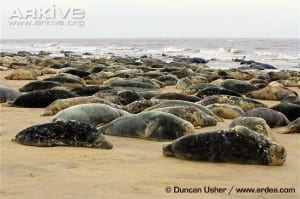What’s the difference between seals and sea lions?
By Jack Ashby, on 26 December 2013
This is one of the easier spots in our “What’s the difference” series, but also one of the most commonly erred of all the picked nits. Zoologists are a pedantic bunch, and whilst correcting people just to demonstrate that you know more than them is not an effective engagement model, the world would be a better place* if more people landed on the right side of the seal vs sea lion dichotomy. The difference is, after all, at the same taxonomic level as otters and red pandas, and few would confuse them.
Seals vs Sea lions: The taxonomy of seal-ish things
All of these things are pinnipeds – a sub-group of the order Carnivora. Pinnipeds are split into three families – True Seals (Phocidae); Eared Seals (Otariidae) and the Walrus (the sole member of Odobenidae).
Let’s dispatch with walruses – they are easy to spot with their tusks.
True seals are the animals that look most like overweight tubes of toothpaste – all of the species we get around the UK are true seals (except for the occasional walrus). Grey seals, leopard seals, elephant seals, harp seals and ringed seals are among the 19 species of true seals.
Eared seals are the 16 species that are commonly named sea lions – because of the males’ manes- and fur seals – because of their dense underfur (for which they were heavily persecuted).
Only true seals are “seals”. Eared seals are not seals; they just look a lot like them.
The two easiest characteristics to look out for when trying to work out whether an animal is a true seal or an eared seal (I expect you can guess what one of them is) are…
Q: Can it walk?
No: It’s a seal.
Yes: It’s an eared seal.
This is because eared seals use their forelimbs/front flippers as their main source of propulsion in the water, and as such they are long and strong enough to stand and walk on when on land. Additionally, eared seals can bring their hindlimbs forward, underneath their bodies, to lift them off the ground when walking, Eared seals are therefore much more upright.
True seals, by contrast, use their hind-quarters to swim with, and their front flippers only to steer. The front limbs are short – buried in the body up to the hand – and useless for walking on. The hindlimbs trail permanently behind the body and cannot be brought forward, and are also useless for walking. As a result, seals tend to look like an obese caterpillar on land, using a gait that I am attempting to coin as “flobelling”.
Q: Does it have ears?
No: It’s a seal.
Yes: It’s an eared seal.
Eared seals have a visible external flap of cartilage (a pinna). I can’t find a Just So Story** for why that is.
Another major difference that can’t be readily discerned is that true seals rely on a thicker layer of blubber for insulation, while eared seals have less blubber but a thick woolly pelt which is largely waterproof.
Relationships
Current consensus is that the pinnipeds form a monophyletic group (they are each others’ closest relatives, with no other members), with mustelids or bears as the most closely related family.
Walruses and true seals are more closely related to each other than either is to eared seals. Walruses show an interesting mix of characters – they can bring their forelimbs forward to stand on like an eared seal, but can’t do so with their hind limbs. They lack external ears, and also much in the way of hair.
*You may think this a wild exaggeration, but I contend that if we respected diversity enough to split its many wonders into enough groups to discern difference between groups like seals and sea lions, perhaps the appreciation inherent in such a philosophy would make a difference to the world.
** Adaptive reason
Jack Ashby is the Manager of the Grant Museum of Zoology.
3 Responses to “What’s the difference between seals and sea lions?”
- 1
-
2
True and False Animals | UCL UCL Museums & Collections Blog wrote on 10 January 2014:

[…] before when is comes to sea stars vs starfish. my colleague Jack Ashby wrote about when it comes to seals and sea lions. Consider also that a musk ox is a goat-antelope, horseshoe crabs aren’t crabs at all and the […]
- 3
 Close
Close




“the animals that look most like overweight tubes of toothpaste” = entirely accurate.